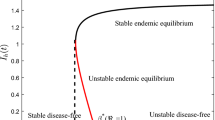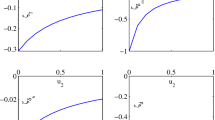Abstract
In this paper, an epidemic model of dengue fever with time delay and saturated incidence rate is studied. The basic reproduction number is calculated by the next-generation matrix method. The local stability of each of feasible equilibria is obtained by analyzing the corresponding characteristic equations. Lyapunov functional method and LaSalle’s invariance principle are used to prove that the disease-free equilibrium is globally asymptotically stable when the basic reproduction number is less than 1; when the basic reproduction number is greater than 1, the endemic equilibrium is globally asymptotically stable. Further, optimal control strategy for the prevention and control of dengue fever infection is suggested based on Pontryagin’s minimum principle with delay. In addition, sensitivity analysis is carried out on basic reproduction number and numerical simulation of the dengue outbreak in Guangdong, in 2014, is given to illustrate the rationality of the model.






Similar content being viewed by others
References
Achee, N.L., Gould, F., Perkins, T.A., et al.: A critical assessment of vector control for dengue prevention. PLoS Neglect. Trop. D. 9(5), 1–19 (2015)
Beretta, E., Kuang, Y.: Geometric stability switch criteria in delay differential systems with delay dependent parameters. Siam J. Math. Anal. 33, 1144–1165 (2002)
Cai, L., Guo, S., Li, X., et al.: Global dynamics of a dengue epidemic mathematical model. Chaos Solitons & Fractal. 42(4), 2297–2304 (2009)
Cai, L., Li, X.: Global analysis of a vector-host epidemic model with nonlinear incidences. Appl. Math. Comput. 217(7), 3531–3541 (2010)
Cai, L., Li, X., Fang, B., et al.: Global properties of vector-host disease models with time delays. J. Math. Biol. 74(6), 1397–1423 (2017)
Capasso, V., Serio, G.: A generalization of the Kermack-McKendrick deterministic epidemic model. Math. Biosci. 42(1–2), 43–61 (1978)
van den Driessche, P., Watmough, J.: Reproduction numbers and sub-threshold endemic equilibria for compartmental models of disease transmission. Math. Biosci. 180(1–2), 29–48 (2002)
Ding, D., Wang, X., Ding, X.: Global stability of multigroup dengue disease transmission model. J. Appl. Math. 2012(3), 1–11 (2012)
Esteva, L., Vargas, C.: Analysis of a dengue disease transmission model. Math. Biosci. 150(2), 131–151 (1998)
Esteva, L., Vargas, C.: A model for dengue disease with variable human population. J. Math. Biol. 38(3), 220–240 (1999)
Fleming, W.H., Rishel, R.W.: Deterministic and Stochastic Optimal Control. Springer, New York (1975)
Feng, Z., Velasco-Hernndez, J.X.: Competitive exclusion in a vector-host model for the dengue fever. J. Math. Biol. 35(5), 523–544 (1997)
Göllmann, L., Kern, D., Maurer, H.: Optimal control problems with delays in state and control variables subject to mixed control-state constraints. Optim. Contr. Appl. Met. 30(4), 341–365 (2010)
Guo, S., Li, X., Ghosh, M.: Analysis of a dengue disease model with nonlinear incidence. Discrete Dyn. Nat. Soc. Article ID 320581, 10 pages (2013). https://doi.org/10.1155/2013/320581
Gakkhar, S., Mishra, A.: A dengue model incorporating saturation incidence and human migration. AIP Conf. Proc. 1651, 64–69 (2015)
Hethcote, H.W., van den Driessche, P.: Some epidemiological models with nonlinear incidence. J. Math. Biol. 29(3), 271–287 (1991)
Hale, J., Lunel, S.M.V.: Introduction to Functional Differential Equations. Springer, New York (1993)
Kuang, Y.: Delay Differential Equations: With Applications in Population Dynamics. Academic Press (1993)
Laarabi, H., Abta, A., Hattaf, K.: Optimal control of a delayed SIRS epidemic model with vaccination and treatment. Acta Biotheor. 63(2), 87–97 (2015)
Liu, W., Levin, S., Iwasa, Y.: Influence of nonlinear incidence rates upon the behavior of SIRS epidemiological models. J. Math. Biol. 23(2), 187–204 (1986)
Li, M., Sun, G., Yakob, L., et al.: The driving force for 2014 dengue outbreak in Guangdong. China. PLoS One. 11(11), 1–19 (2016)
Martcheva, M.: An Introduction to Mathematical Epidemiology. Spinger, New York (2015)
Marino, S., Hogue, I.B., Ray, C., et al.: A methodology for performing global uncertainty and sensitivity analysis in systems biology. J. Theoret. Biol. 254(1), 178–196 (2009)
Magal, P., Mccluskey, C.C., Webb, G.F.: Lyapunov functional and global asymptotic stability for an infection-age model. Appl. Anal. 9(7), 1109–1140 (2010)
Tewa, J., Dimi, J., Bowong, S.: Lyapunov functions for a dengue disease transmission model. Chaos Solitons & Fractal. 39(2), 936–941 (2009)
World Health Organization (WHO), web page: https://www.who.int/zh/
World Health Organization (2020). Available from: https://www.who.int/en/news-room/fact-sheets/detail/dengue-and-severe-dengue
Wu, J., Lun, Z., James, A.A., et al.: Dengue fever in mainland China. Am. J. Trop. Med. Hyg. 83(3), 664–671 (2010)
Wang, W., Zhao, X.Q.: A nonlocal and time-delayed reaction-diffusion model of dengue transmission. Siam J. Appl. Math. 71(1), 147–168 (2011)
Wang, Z., Zhao, X.Q.: Global dynamics of a time-delayed dengue transmission model. Can. Appl. Math. Q. 20(1), 89–113 (2012)
Xu, R., Du, Y.: A delayed SIR epidemic model with saturation incidence and a constant infectious period. J. Appl. Math. Comput. 35(1–2), 229–250 (2011)
Yang, H., Wei, H., Li, X.: Global stability of an epidemic model for vector-borne disease. J. Syst. Sci. Complex. 23, 279–292 (2010)
Acknowledgements
This work was supported by the National Natural Science Foundation of China (Nos. 11871316, 11801340) and the Natural Science Foundation of Shanxi Province, China (Nos. 201801D121006, 201801D221007).
Author information
Authors and Affiliations
Corresponding author
Additional information
Publisher's Note
Springer Nature remains neutral with regard to jurisdictional claims in published maps and institutional affiliations.
Rights and permissions
About this article
Cite this article
Wang, B., Tian, X., Xu, R. et al. Threshold dynamics and optimal control of a dengue epidemic model with time delay and saturated incidence. J. Appl. Math. Comput. 69, 871–893 (2023). https://doi.org/10.1007/s12190-022-01766-3
Received:
Revised:
Accepted:
Published:
Issue Date:
DOI: https://doi.org/10.1007/s12190-022-01766-3




